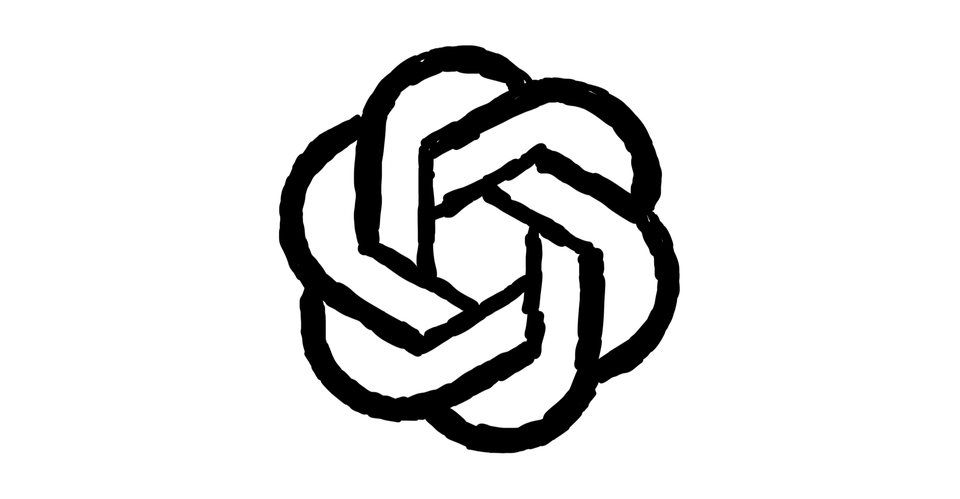Drawing the ChatGPT logo

In the latest episode of Sharp Tech, Ben Thompson lamented his poor recreation of the ChatGPT logo.
For years, Ben has used Linea Sketch on the iPad to illustrate technical concepts.1
Those have made their way onto his Stratechery blog, and I’ve been an appreciative recipient of the visuals that try to walk through complex ideas.
Ben does a great job with this, and it was the inspiration for some of the work I did with Google years ago. At one point, I sketched out an entire keynote presentation by hand, and my colleagues at Google used that to give a slideshow talk. We were able to look at Ben’s blog as proof that the idea was worth doing. The sketching involved hand tracing a bunch of logos, so the struggle Ben shared was one I dealt with a bunch.
Ben was frustrated at not being able to replicate the ChatGPT logo. The end result of his work was something squished and weirdly shaped, even though it still vaguely resembled the logo. He spent a lot of time trying to get it just right, and ultimately had to ship something that he’s not fully proud of—to the point that they ended up discussing it for several minutes on the podcast.
As I listened to the episode, I realized there was an obvious solution, but one that most people wouldn’t realize unless they’d been trained in art professionally—or just stumbled across it in some way.
Years ago, I had a fantastic art teacher. I loved her style of teaching so much that I took two extra classes from her, both of which didn’t count toward anything other than general credits.
There’s a lot of things she hammered home2, but one that stuck with me was the value of tracing, copying the amazing artists of old, and straight-up stealing from the greats that came before us.
Much of my initial time in class was spent just tracing. This was before iPads, and even Wacom tablets were barely a thing, so what we used was vellum paper.3
We’d put a drawing from one of the greats down on our desk, then put vellum over that, with a light source properly aimed at the original. Using a pencil, we could then trace over it.
The value of that was to learn how the artist had made the art. By spending hours copying line by line4, I started to understand how the pieces came to life, how muscles moved, how the humans on the page tensed, prepared for action. All this time literally copying brush strokes, helped get me into the mind of the original.
Straight-up copying had value all its own as I just spent time learning. The best way to learn is by studying. Yes, we want to make our own art and bring originality into the work, but first we have to know what’s come before in at least some manner.
So back to Ben’s example.
It didn’t once occur to him to copy the ChatGPT logo full hog. Instead, he tried to replicate it while looking at the original.
My suggestion to him, in the email I quickly dashed off, was to trace the ChatGPT logo, still having his organic art style, and using that to get the correct design, while making sure things felt like they belonged with all the other illustrations he’s done over the years.
Is this cheating? No, not at all. You could go from memory, go from a reference, or trace the reference.
In this example, it’s clear that you copied the original, but added your own flair and handwritten style to it. I spent just a few minutes and managed to create a very natural feeling logo, but one which is more technically accurate.
Given that so much illustration and art in general is being erroded by AI, I see here a chance to push back. We can still copy the output of AI, or a logo done by someone else, and take it back into our own form of art—in this case hand re-drawing the original drawings. It’s a way to put our unique flavor into the world, to show others that we care, and that we’re here.
1. I’m more partial to Freeform these days.
2. She had a particular frustration with Thomas Kinkade that was surprisingly jaded, given how kind and supportive she was in every other area of her teaching. She felt that he’d sold out and used his incredible talent to cheapen the product and turn art into a commodity. I’d love to pick her brain on how she feels about ChatGPT and AI art in general today.
3. This stuff is seriously amazing. Take a piece of art from a book, or even your phone, and place vellum over it. It lets most of the light through, but there’s just enough paper that you can trace onto the page. It has a lot of uses, but the biggest purpose for me as a teen was actually being able to see the original art underneath.
4. I got my start tracing all kinds of stuff, and was able to really drive that home with Neopets.

Member discussion